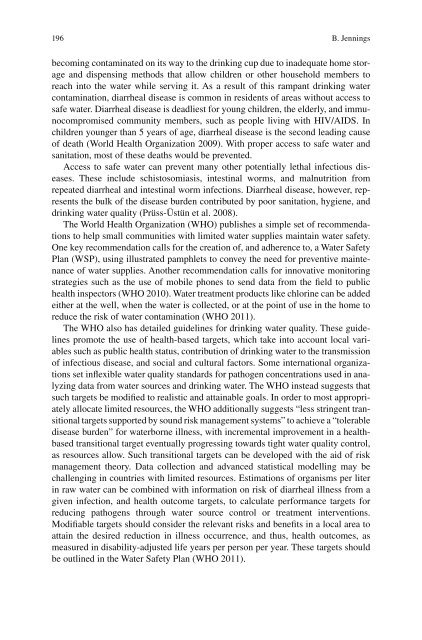Public Health Ethics - Global Cases, Practice, and Context, 2016a
Public Health Ethics - Global Cases, Practice, and Context, 2016a
Public Health Ethics - Global Cases, Practice, and Context, 2016a
You also want an ePaper? Increase the reach of your titles
YUMPU automatically turns print PDFs into web optimized ePapers that Google loves.
196<br />
B. Jennings<br />
becoming contaminated on its way to the drinking cup due to inadequate home storage<br />
<strong>and</strong> dispensing methods that allow children or other household members to<br />
reach into the water while serving it. As a result of this rampant drinking water<br />
contamination, diarrheal disease is common in residents of areas without access to<br />
safe water. Diarrheal disease is deadliest for young children, the elderly, <strong>and</strong> immunocompromised<br />
community members, such as people living with HIV/AIDS . In<br />
children younger than 5 years of age, diarrheal disease is the second leading cause<br />
of death (World <strong>Health</strong> Organization 2009 ). Wit h proper access to safe water <strong>and</strong><br />
sanitation, most of these deaths would be prevented.<br />
Access to safe water can prevent many other potentially lethal infectious diseases<br />
. These include schistosomiasis, intestinal worms, <strong>and</strong> malnutrition from<br />
repeated diarrheal <strong>and</strong> intestinal worm infections. Diarrheal disease , however, represents<br />
the bulk of the disease burden contributed by poor sanitation , hygiene, <strong>and</strong><br />
drinking water quality (Prüss-Üstün et al. 2008 ).<br />
The World <strong>Health</strong> Organization (WHO) publishes a simple set of recommendations<br />
to help small communities with limited water supplies maintain water safety.<br />
One key recommendation calls for the creation of, <strong>and</strong> adherence to, a Water Safety<br />
Plan (WSP) , using illustrated pamphlets to convey the need for preventive maintenance<br />
of water supplies. Another recommendation calls for innovative monitoring<br />
strategies such as the use of mobile phones to send data from the field to public<br />
health inspectors (WHO 2010 ). Water treatment products like chlorine can be added<br />
either at the well, when the water is collected, or at the point of use in the home to<br />
reduce the risk of water contamination (WHO 2011 ).<br />
The WHO also has detailed guideline s for drinking water quality. These guidelines<br />
promote the use of health-based targets , which take into account local variables<br />
such as public health status, contribution of drinking water to the transmission<br />
of infectious disease , <strong>and</strong> social <strong>and</strong> cultural factors. Some international organizations<br />
set inflexible water quality st<strong>and</strong>ards for pathogen concentrations used in analyzing<br />
data from water sources <strong>and</strong> drinking water. The WHO instead suggests that<br />
such targets be modified to realistic <strong>and</strong> attainable goals. In order to most appropriately<br />
allocate limited resources, the WHO additionally suggests “less stringent transitional<br />
targets supported by sound risk management systems ” to achieve a “tolerable<br />
disease burden ” for waterborne illness, with incremental improvement in a healthbased<br />
transitional target eventually progressing towards tight water quality control,<br />
as resources allow. Such transitional targets can be developed with the aid of risk<br />
management theory. Data collection <strong>and</strong> advanced statistical modelling may be<br />
challenging in countries with limited resources. Estimations of organisms per liter<br />
in raw water can be combined with information on risk of diarrheal illness from a<br />
given infection, <strong>and</strong> health outcome targets , to calculate performance targets for<br />
reducing pathogens through water source control or treatment interventions.<br />
Modifiable targets should consider the relevant risks <strong>and</strong> benefits in a local area to<br />
attain the desired reduction in illness occurrence, <strong>and</strong> thus, health outcomes, as<br />
measured in disability-adjusted life years per person per year. These targets should<br />
be outlined in the Water Safety Plan (WHO 2011 ).


















